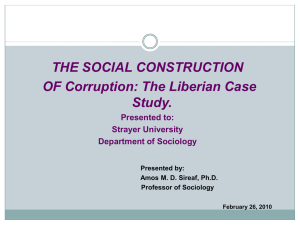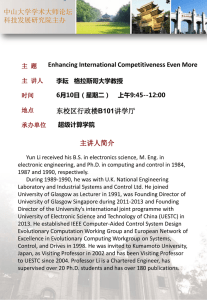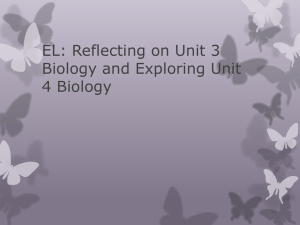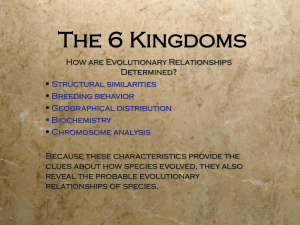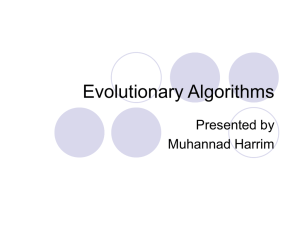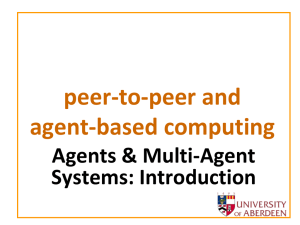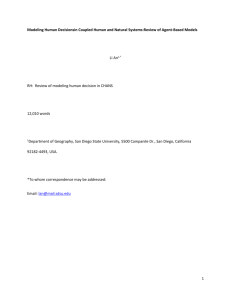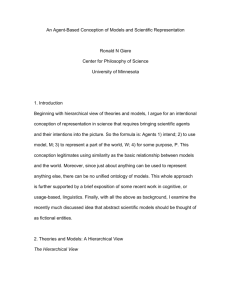Eric Beinhocker
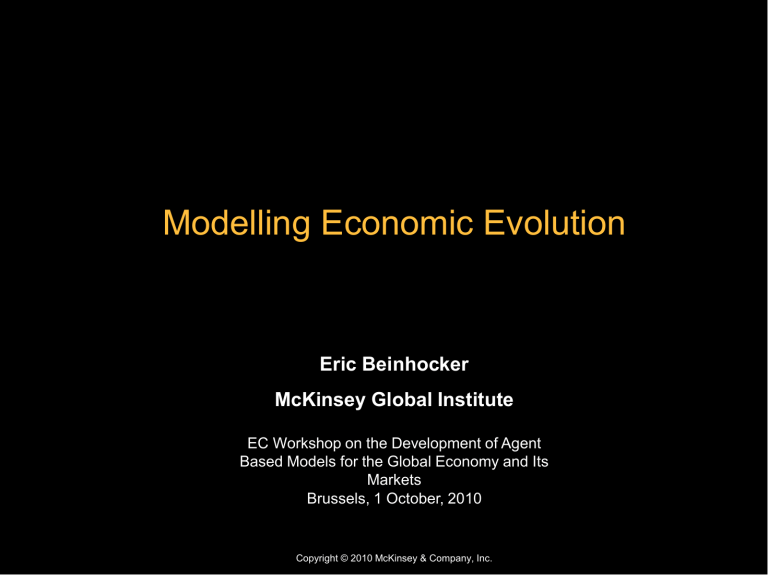
Modelling Economic Evolution
Eric Beinhocker
McKinsey Global Institute
EC Workshop on the Development of Agent
Based Models for the Global Economy and Its
Markets
Brussels, 1 October, 2010
Copyright © 2010 McKinsey & Company, Inc.
Today’s discussion
•
Facts – five empirical observations to be explained
•
Proposal – economic change as evolutionary search through physical, social, and economic design spaces
•
Implications for agent-based modelling
1
Today’s discussion
•
Facts – five empirical observations to be explained
•
Proposal – economic change as evolutionary search through physical, social, and economic design spaces
•
Implications for agent-based modelling
2
Fact no. 1 – discontinuous economic growth
World GDP per capita, constant 1992 US$
2.5m BC to 2000 AD
7000
15,000 BC to 2000 AD
7000
1750 to 2000
7000
6000
5000
4000
3000
2000
1000
0
-2500000 -1500000 -500000
6000
5000
4000
3000
6000
5000
4000
3000
2000
1000
2000
1000
0
-15000 -10000 -5000 0 5000
0
1700 1800 1900 2000 2100
Source: J. Bradford DeLong, U. Cal. Berkeley 3
Fact no. 2 – increased order and complexity
From . . .
To . . .
10 2 SKU economy 10 10 SKU economy
•
Wal-Mart 100,000 SKUs
•
Cable TV 200+ channels
•
275 breakfast cereals
4
Fact no. 3: evolutionary patterns in technology
“Add successfully as many mail coaches as you please, you will never get a railway thereby”
Joseph Schumpeter
5
Fact no. 4: economies are physical systems subject to the laws of thermodynamics
Low order inputs
Interacting agents
Ordered outputs – goods and services
(entropy locally decreased)
•
Food calories
•
Fossil fuels
•
Raw materials
•
Information Disordered outputs – waste products, heat, gases
(entropy exported – universally increasing)
Economic activity is fundamentally an order creating process
(Georgescu-Roegen)
6
Fact no. 5 – no one is in charge
7
Today’s discussion
•
Facts – five empirical observations to be explained
•
Proposal – economic change as evolutionary search through physical, social, and economic design spaces
•
Implications for agent-based modelling
8
A paradigm shift
Dynamics
Agents
Networks
Emergence
Evolution
Neoclassical economics
Economies are closed, static, linear systems in equilibrium
Homogeneous agents
•
Only use rational deduction
•
Make no mistakes/no biases
•
Already perfect, so why learn?
Assume agents only interact indirectly through market mechanisms
Treats micro and macroeconomics as separate disciplines
Contains no endogenous mechanism for creating novelty or growth in order and complexity
Complexity economics
Economies are open, dynamic, non-linear systems far from equilibrium
Heterogeneous agents
•
Mix deductive/inductive decision-making
•
Subject to errors and biases
•
Learn and adapt over time
Explicitly account for agent-toagent interactions and relationships
Sees no distinction between micro- and macroeconomics; macro patterns emerge from micro behaviors and interactions
Evolutionary process creates novelty and growing order and complexity over time
9
Do we need evolution in agent-based models?
Complexity economics
Dynamics
Economies are open, dynamic, non-linear systems far from equilibrium
Agents
Networks
Emergence
Evolution
Agent-based models typically good at this
Do we also need this?
Heterogeneous agents
•
Mix deductive/inductive decision-making
•
Subject to errors and biases
•
Learn and adapt over time
Explicitly account for agent-toagent interactions and relationships
Sees no distinction between micro- and macroeconomics; macro patterns emerge from micro behaviors and interactions
Evolutionary process creates novelty and growing order and complexity over time
10
Evolution as a form of computation
Algorithms
Search algorithms Other types of algorithms
Evolutionary search algorithms
Human social evolution
Non-evolutionary search algorithms
Other evolution
Biological evolution
Physical technologies
Social technologies
Business
Plans
Culture?
Other?
Coevolution
11
Evolution is a search algorithm for ‘fit designs’
Create a variety of experiments
Select designs that are ‘fit’
Amplify fit designs, de-amplify unfit designs
Variation Selection
Repeat
Amplification
12
A generic model of evolution
Design space Schema
1
0
0
0
0
0
1
0
1
1
Schema
Reader – Builder
1
0
0
0
0
0
1
1
1
0
Interactor
Environment
13
Evolution creates complexity from simplicity
Energy
Information
World
Physical
World
Rendering of design
1
0
1
1
0
0
0
0
1
0
Variation, selection, amplification
Feedback on
Design encoded in a schema fitness
Interactor in an environment
Order, complexity
14
Applying a computational view to social systems
Design space Schema Schema Reader – Builder
Design
A
BUSINESS
PLAN
MegaCorp
Physical artefacts
Social structures
Economic designs
15
Who designed the modern bicycle?
16
The reality – evolution through ‘deductive-tinkering’
17
Technologies evolve
18
Economic evolution occurs in three ‘design spaces’
Physical technologies
Business plans
Social technologies
19
Business plan evolution works at three levels
Individual minds Markets
A?
C?
B?
D?
E?
Organizations
A+C?
A?
D?
E?
6?
B+D+E?
Independent booksellers
20
What would economic evolution predict?
•
Periods of stasis/bursts of innovation
•
Spontaneous self organization
•
Increasing economic order
(non-monotonic), increasing pollution
21
Today’s discussion
•
Facts – five empirical observations to be explained
•
Proposal – economic change as evolutionary search through physical, social, and economic design spaces
•
Implications for agent-based modelling
22
Should we include innovation processes in agentbased models?
It depends…
•
Stock market model testing options for institutional structure
– PROBABLY NO
•
Macro model exploring short-term options for monetary and fiscal policy – PROBABLY NO
•
Model of the financial crisis – MAYBE
•
Micro model of industry dynamics – YES
•
Multi decade model of climate change mitigation – YES
•
Macro model of long-term growth – YES
23
Options for modelling innovation
•
Exogenous, stochastic process
–What kind of stochastic process?
–No feedback from economy to innovation process
•
Endogenous, increasing returns to R&D (Romer)
–Does not account for variety, complexity
–No networks, inter-relationships between innovations
–No “bursts” of innovation
•
Endogenous, evolutionary
–Genetic algorithms
–Grammar models? Other?
24
Can we incorporate economic evolution in agentbased modelling?
• Imagine agents searching a ‘design space’ (physical technology, social technology, or business plans) for ‘fit designs’
–Finite set of primitives, coded in a schema
–‘Grammar’ for re-combination of primitives into modules and architectures
•
How to model the fitness function, how does it endogenously evolve?
•
Who are the schema-reader/builders? (individuals, firms?)
•
How to model processes for turning schema into interactors (new products and services, new firms)?
•
How can evolution in social technologies change the structure of the model itself?
25
Remember . . .
“Evolution is cleverer than we are”
Orgels’s second rule
26


